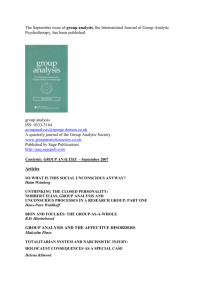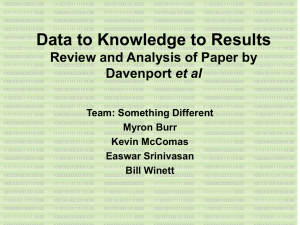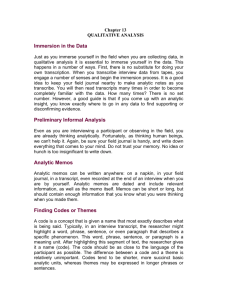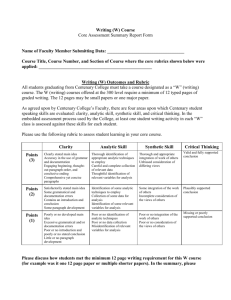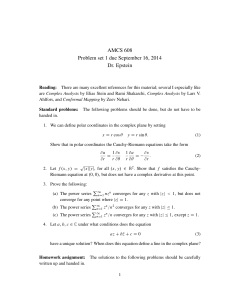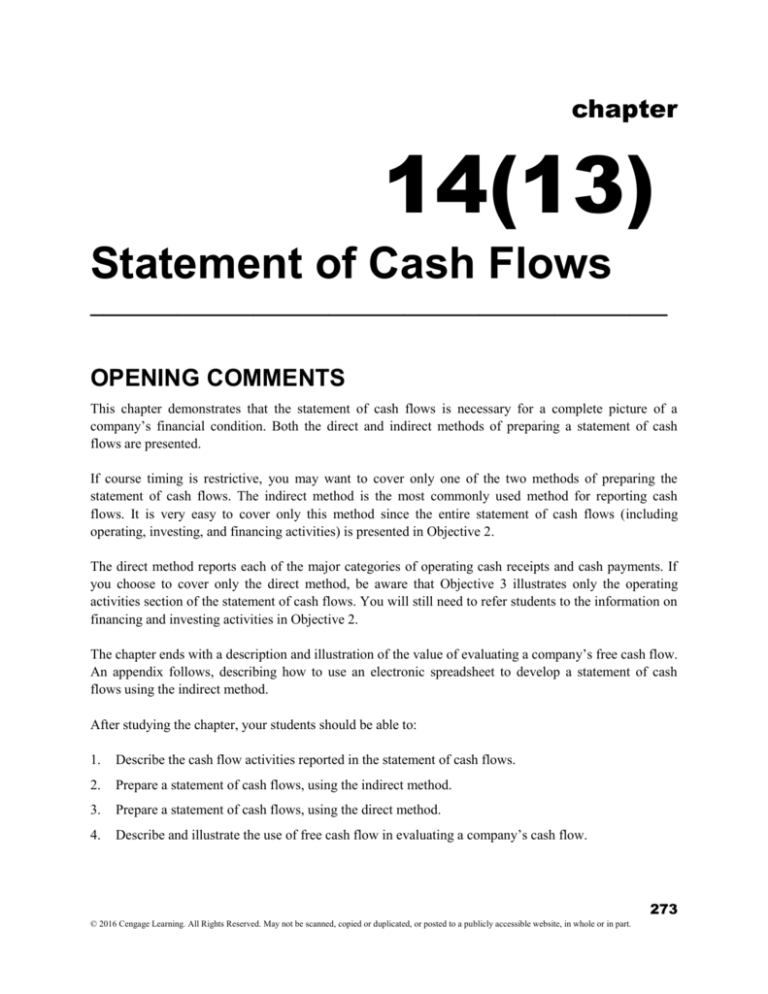
chapter
14(13)
Statement of Cash Flows
______________________________________________
OPENING COMMENTS
This chapter demonstrates that the statement of cash flows is necessary for a complete picture of a
company’s financial condition. Both the direct and indirect methods of preparing a statement of cash
flows are presented.
If course timing is restrictive, you may want to cover only one of the two methods of preparing the
statement of cash flows. The indirect method is the most commonly used method for reporting cash
flows. It is very easy to cover only this method since the entire statement of cash flows (including
operating, investing, and financing activities) is presented in Objective 2.
The direct method reports each of the major categories of operating cash receipts and cash payments. If
you choose to cover only the direct method, be aware that Objective 3 illustrates only the operating
activities section of the statement of cash flows. You will still need to refer students to the information on
financing and investing activities in Objective 2.
The chapter ends with a description and illustration of the value of evaluating a company’s free cash flow.
An appendix follows, describing how to use an electronic spreadsheet to develop a statement of cash
flows using the indirect method.
After studying the chapter, your students should be able to:
1.
Describe the cash flow activities reported in the statement of cash flows.
2.
Prepare a statement of cash flows, using the indirect method.
3.
Prepare a statement of cash flows, using the direct method.
4.
Describe and illustrate the use of free cash flow in evaluating a company’s cash flow.
273
© 2016 Cengage Learning. All Rights Reserved. May not be scanned, copied or duplicated, or posted to a publicly accessible website, in whole or in part.
274
Chapter 14(13)
Statement of Cash Flows
KEY TERMS
cash flow per share
cash flows from financing activities
cash flows from investing activities
cash flows from operating activities
direct method
free cash flow
indirect method
statement of cash flows
STUDENT FAQS
Why do most preparers of cash flow statements prefer the indirect method?
I just don’t see a need for the cash flow statement. Who cares about the cash flow statement since it
tells the reader only where the company’s money came from and where the company’s money was
spent?
Why does the cash flow statement have to equal the change in the cash account?
Why does only the Operating section of the cash flow statement change when preparing the
statement under the two different methods?
If the cash flow statement is so important and helpful, why don’t we prepare all the financial
statements on a cash basis?
Why do we have to prepare a schedule of important noncash items to accompany this statement?
After all, this is the statement that is based on the cash inflows and outflows.
Why are there two methods to prepare the statement of cash flows?
Why are gains and losses on disposals of assets treated as adjustments to the cash flows from
operations but the cash part of the transaction is a source of funds under investing? Shouldn’t it all go
under one section?
Why can’t you assume that a company is financially healthy and liquid if it has a positive cash flow?
OBJECTIVE 1
Describe the cash flow activities reported in the statement of cash flows.
SYNOPSIS
The statement of cash flows reports a company’s cash position: it inflows and outflows. It provides
information that answers questions about how the company generates cash from operations, how it
maintains or expands its operations, how it meets its financial obligations, and whether it has the cash to
pay dividends. The cash flow statement is used by both external and internal users. The cash flow
statement is divided into three sections: the operating activities are the cash flows from transactions that
© 2016 Cengage Learning. All Rights Reserved. May not be scanned, copied or duplicated, or posted to a publicly accessible website, in whole or in part.
Chapter 14(13)
Statement of Cash Flows
275
affect the net income of the company, the investing activities are the cash flows from transactions that
affect investment in noncurrent assets, and the financing activities are the cash flows from transactions
that affect the debt and equity of the company. The ending cash on the statement of the cash flows equals
the cash reported on the balance sheet at the end of the year.
Cash flows from operating activities report the cash inflow and outflow from a company’s day-to-day
operations. In the direct method, the primary operating inflows of cash are received from customers, and
the primary outflows of cash are for merchandise, operating expenses, interest, and tax payments. The
indirect method reports cash flows from operating activities beginning with net income and adjusting it
for revenues and expenses that do not involve the receipt or payment of cash. Both methods result in the
same net cash flow from activities; however, due to the accessibility of the information, the indirect
method is more commonly used. A company may enter into transactions that do not directly affect cash;
they are reported in a separate section at the bottom of the statement of cash flows. The statement of cash
flows format is shown in Exhibit 3.
Key Terms and Definitions
Cash Flow per Share - Normally computed as cash flow from operations per share.
Cash Flows from Financing Activities - The section of the statement of cash flows that reports
cash flows from transactions affecting the equity and debt of the business.
Cash Flows from Investing Activities - The section of the statement of cash flows that reports
cash flows from transactions affecting investments in noncurrent assets.
Cash Flows from Operating Activities - The section of the statement of cash flows that reports
the cash transactions affecting the determination of net income.
Direct Method - A method of reporting the cash flows from operating activities as the difference
between the operating cash receipts and the operating cash payments.
Indirect Method - A method of reporting the cash flows from operating activities as the net
income from operations adjusted for all deferrals of past cash receipts and payments and all
accruals of expected future cash receipts and payments.
Statement of Cash Flows - A summary of the cash receipts and cash payments for a specific
period of time, such as a month or a year.
Relevant Example Exercises and Exhibits
Example Exercise 14(13)-1 Classifying Cash Flows
Exhibit 1 – Sources and Uses of Cash
Exhibit 2 – Cash Flow from Operations: Direct and Indirect Methods—NetSolutions
Exhibit 3 – Format of the Statement of Cash Flows
SUGGESTED APPROACH
Provided below is a Writing Exercise to introduce the statement of cash flows. The exercise asks students
to evaluate financial data from two companies. The goal is to point out that a firm’s profits do not paint a
total picture of its operations; cash flow data is also needed. Follow the Writing Exercise [Transparency
Master (TM) 14(13)-1] by reviewing TM 14(13)-2, which lists the benefits of a statement of cash flows.
A Lecture Aid is also provided here for reviewing the content of each section of the cash flow statement.
© 2016 Cengage Learning. All Rights Reserved. May not be scanned, copied or duplicated, or posted to a publicly accessible website, in whole or in part.
276
Chapter 14(13)
Statement of Cash Flows
WRITING EXERCISE—Importance of the Statement of Cash Flows
TM 14(13)-1 presents financial information taken from the accounting records of two companies. These
companies have the same net incomes but very different cash flows. Even though both companies have
the same sales, Company B did not collect as much cash from its customers. In addition, Company B did
not invest as much cash in fixed assets; this could inhibit future growth.
Show this data to your students and ask them to comment, in writing, on any strengths or weaknesses they
see in the two companies. After giving them a few minutes to study the information and write their
comments, review their responses.
Possible response: Company B has maintained its cash position by selling fixed assets, while Company
A is investing in fixed assets. This would bring into question the ability of Company B to remain
competitive with Company A for future production. Additionally, the inability to collect from customers
would bring into question the credit decisions Company B has been making, possibly granting credit to
questionable customers to maintain sales. Company A has also been able to invest some surplus cash to
provide returns, from which Company B will not have the same benefits.
LECTURE AID—Statement of Cash Flows
TMs 14(13)-3 and 14(13)-4 list the three sections of the statement of cash flows and the transactions
included in each section. TM 14(13)-5 defines the content of the schedule of noncash investing and
financing activities.
After reviewing these TMs, you may want to discuss the treatment of interest on debt and
interest/dividends on investments in the statement of cash flows. These transactions can be called the
“three foolers,” because students typically want to identify them as financing and investing activities
instead of operating activities. Use TM 14(13)-6 for this purpose.
Have students identify cash flows from operating, investing, and financing activities from their personal
experiences. Some examples are listed below:
Operating activities: Cash inflows from a job, cash outflows for food or rent
Financing activities: Cash inflow from a student loan
Investing activities: Cash outflow for an automobile; cash inflow from selling a motorcycle
OBJECTIVE 2
Prepare a statement of cash flows, using the indirect method.
SYNOPSIS
Using the indirect method of reporting cash flows for operating activities, a comparison is made between
the account balances at the beginning and end of the year. By analyzing changes in noncash balance sheet
accounts, changes in the cash account are determined indirectly. The equation, change in cash = change in
© 2016 Cengage Learning. All Rights Reserved. May not be scanned, copied or duplicated, or posted to a publicly accessible website, in whole or in part.
Chapter 14(13)
Statement of Cash Flows
277
liabilities + change in stockholders’ equity – noncash assets, shows how this method is used. To prepare
the statement of cash flows, an income statement for the period is required and two balance sheets, one
from the beginning of the period and one from the end of the period. Because net income is determined
using the accrual method, it must be adjusted to determine cash flows from operating activities. Exhibit 5
shows the adjustments to net income for the direct method: expenses that do not affect cash are added,
losses on the disposal of assets are added and gains are deducted, and finally changes in current assets and
liabilities are added or deducted. Exhibit 6 demonstrates how the operating activities are calculated. The
Investing Activities section is completed by analyzing the changes in noncurrent assets. The Financing
Activities section is completed by analyzing the changes in stock, dividends, and long-term liabilities.
Relevant Example Exercises and Exhibits
Example Exercise 14(13)-2 Adjustments to Net Income—Indirect Method
Example Exercise 14(13)-3 Changes in Current Operating Assets and Liabilities—Indirect
Method
Example Exercise 14(13)-4 Cash Flows from Operating Activities—Indirect Method
Example Exercise 14(13)-5 Land Transactions on the Statement of Cash Flows
Exhibit 4 – Income Statement and Comparative Balance Sheet
Exhibit 5 – Adjustments to Net Income (Loss) Using the Indirect Method
Exhibit 6 – Net Cash Flow From Operating Activities—Indirect Method
Exhibit 7 – Statement of Cash Flows—Indirect Method
SUGGESTED APPROACH
Open your discussion of the indirect method with a basic outline of the reconciliation prepared in the
Operating Activities section. TM 14(13)-7 presents an overview of the reconciliation process. You will
also want to illustrate this process by preparing a statement of cash flows as a demonstration problem.
LECTURE AID—Indirect Method
During your discussion of TM 14(13)-7 (the reconciliation of net income to net cash flows from operating
activities), stress the following points:
1.
Noncash expenses must be added to remove these expenses from net income. They must be removed
from net income because they did not cause cash to be paid out.
Ask your students to identify examples of noncash items reported on the income statement and
whether they would be added to or deducted from net income to determine cash flows from operating
activities. Several examples are listed below.
Noncash Item
Depreciation
Amortization of bond discount
Amortization of bond premium
Amortization of patents
Depletion expense
Treatment
Added to net income
Added to net income
Deducted from net income
Added to net income
Added to net income
© 2016 Cengage Learning. All Rights Reserved. May not be scanned, copied or duplicated, or posted to a publicly accessible website, in whole or in part.
278
2.
Chapter 14(13)
Statement of Cash Flows
Any gains or losses on investing and financing activities affect the amount of cash that was received
from selling investments or the amount of cash paid when settling debts. Because these activities are
reported in the investing and financing sections of the statement of cash flows, the gain or loss
included in the calculation of net income must be removed to isolate operating cash flows.
For example, a building with a $50,000 book value is sold for $125,000—a $75,000 gain. The
$75,000 gain must be removed from net income because it does not represent cash received from
operations (buying and selling merchandise). The entire $125,000 cash proceeds from the building
(which includes the gain) will be disclosed in the investing activities section. Remind students that
losses are added and gains are subtracted to remove them from the net income.
3.
Changes in current assets and current liability accounts related to operating activities must be
considered to remove the effects of accrual accounting from net income and return to a cash-basis
measure of operations. Emphasize that net cash flow from operating activities is different from net
income because the income statement is based on the accrual basis of accounting. The statement of
cash flows presents cash basis accounting.
DEMONSTRATION PROBLEM—Preparing a Statement of Cash Flows:
Indirect Method
Because of the amount of data required to prepare a statement of cash flows, it is appropriate to use a
problem from the text to demonstrate the preparation of the statement of cash flows. If you plan to cover
the direct method of reporting cash flows, use Problem 14(13)-1A or 14(13)-1B to demonstrate the
indirect method. Next, use Problems 14(13)-5A or 14(13)-5B to illustrate the Operating Activities section
on a direct method statement of cash flows. Problems 14(13)-5A and 14(13)-5B provide the additional
information needed to do a direct statement for the same company in 14(13)-1A and 14(13)-1B.
Therefore, you can save class time by doing the entire statement under the indirect method but only the
Operating Activities section under the direct method.
Instruct your students to complete a couple of preparatory steps before attacking a cash flow problem.
First, ask them to calculate the increase or decrease for every account on the balance sheet and write it in
the margin of the text. When working through a demonstration problem, give them a few minutes of class
time to complete this step on their own.
You may want to use the following algebraic proof to demonstrate why students need to calculate the
amount by which each account on the balance sheet has increased or decreased:
Assets = Liabilities + Stockholders’ Equity
Cash + Noncash Assets = Liabilities + Stockholders’ Equity
© 2016 Cengage Learning. All Rights Reserved. May not be scanned, copied or duplicated, or posted to a publicly accessible website, in whole or in part.
Chapter 14(13)
Statement of Cash Flows
279
Therefore,
Change in
Change in
Change in
Change in
Cash
+ Noncash Assets = Liabilities + Stockholders’ Equity
or
Change in
Change in
Change in
Change in
Cash
= Liabilities
+ Stockholders’ Equity – Noncash Assets
If you can explain what caused your Noncash Assets, Liabilities, and Stockholders’ Equity account
balances to change, you have explained what caused the Cash account balance to change.
The second preparatory step is to go through the balance sheet accounts and note where the change in
each account balance will be reported (“O” for operating activities, “I” for investing activities, and “F” for
financing activities). A few accounts, namely Retained Earnings and Accumulated Depreciation, must be
considered when preparing two sections of the statement of cash flows.
You will probably want to lead students through this step, instructing them to place an O, I, or A by each
account title in the example problem. The accounts in Problem 14(13)-1A or 14(13)-1B would be coded
as follows:
Cash (no code—this is the number we are trying to explain)
Accounts Receivable—O
Inventories—O
Investments—I
Land—I
Equipment—I
Accumulated Depreciation—O and I
Accounts Payable—O
Accrued Expenses—O
Dividends Payable— F
Common Stock—F
Paid-in Capital—F
Retained Earnings—O and F
Now your students are ready to attack the problem, beginning with the Operating Activities section.
Students should be encouraged to use a “check-off” method in completing the statement of cash flows.
The basics of the check-off method are as follows: When the total change in an account has been
explained, check it off. Once an account has been checked off, you don’t need to look at it again.
For example, the first step in the Operating Activities section is to show the amount of net income. This
information is obtained from the income statement or, in accounting class, from the “additional
information” accompanying the problem. Net income is closed to the retained earnings account; however,
in Problem 14(13)-1A, retained earnings increased by $118,280 even though net income was $190,280.
Some other transaction must be affecting the account. Because the change in the account balance has not
been fully explained, the account cannot be checked off. As the coding system shows, students must look
at retained earnings again when preparing the Financing Activities section.
© 2016 Cengage Learning. All Rights Reserved. May not be scanned, copied or duplicated, or posted to a publicly accessible website, in whole or in part.
280
Chapter 14(13)
Statement of Cash Flows
The next step in the Operating Activities section is to add back any depreciation, amortization, or
depletion. What account on the balance sheet would contain the depreciation for the year? (Answer:
Accumulated Depreciation) However, that account is also affected by entries to remove fixed assets when
sold or discarded. In Problem 14(13)-1A, we are told that there were no disposals of equipment.
Therefore, the only entry in the accumulated depreciation account would be the adjusting entry for the
year’s depreciation expense. The $13,800 change in this account is the depreciation expense to be added
to net income. Because the change in the account balance has been fully explained, the accumulated
depreciation account can be checked off. Those are the basic steps in the check-off method.
At this time, instruct your students to review the additional information given with the problem to look
for any gains and losses on investing and financing activities. Remind them that gains and losses occur
only when assets are sold and liabilities settled. Problem 14(13)-1A has a $30,000 gain on the sale of
investments that must be deducted from net income.
Ask your students to answer the following questions: (1) If there had been a loss of $20,000 on the sale of
investments, how would this be reported in the Operating Activities section of the statement of cash
flows? (Answer: The loss would be added to net income.) (2) If fully depreciated equipment had been
sold for $2,000, how would this be reported in the Operating Activities section of the statement of cash
flows? (Answer: The $2,000 gain would be deducted from net income.)
Now it is time to look at the current assets and current liabilities related to operations. Instruct your
students to go through the accounts coded with “O” and write down whether each account increased or
decreased and by what amount. Then, ask your students to determine whether the change had a positive or
negative effect on cash. Many students want to cling to text Exhibit 4 to assist with this task, so try to give
them a logical approach to determine how account changes affect cash.
The suggested explanations are overly simplified and, therefore, not “totally” accurate. However, most of
your students will find them useful. For example, accounts receivable in Problems 14(13)-1A and 14(13)1B increased. A simplified explanation of how this affects cash flows follows:
If accounts receivable went up, did you sell more or less on credit? More. If you sold more on credit, did
you sell more or less for cash? Less. If you sold less on cash, what was the effect on the Cash account? It
decreased. Therefore, the change in accounts receivable is subtracted.
Now, in reality, accounts receivable may have increased because customers are paying more slowly.
Accounts receivable also may have increased simply because total sales increased without a
corresponding increase in cash sales. When insightful students bring up these arguments, agree with them.
Point out that the original explanation is useful because it is simple and tends to make sense to most
students.
When accounts receivable decrease, your explanation is the inverse: The company sold less on credit, so
it sold more for cash and the Cash account is increased. Explanations for changes in other accounts
follow:
1. Increase in Inventory: The company bought more inventory, so it has to pay for more inventory. Cash
is decreased.
© 2016 Cengage Learning. All Rights Reserved. May not be scanned, copied or duplicated, or posted to a publicly accessible website, in whole or in part.
Chapter 14(13)
Statement of Cash Flows
281
2. Decrease in Inventory: The company bought less inventory, so it doesn’t have to pay for as much
inventory. Cash is increased.
3. Increase in Prepaid Expense: The company has prepaid more expenses using its cash. Cash is
decreased.
4. Decrease in Prepaid Expense: The company has prepaid fewer expenses, saving its cash. Cash is
increased.
5. Increase in Accounts Payable: The company has bought more on credit, so it has bought less with
cash. Cash is increased.
6. Decrease in Accounts Payable: The company has bought less on credit, so it is buying more with
cash. Cash is decreased.
Once all accounts marked “O” have been checked off, it is time to move on to the investing and financing
accounts. Work through these accounts one by one, using the additional information to determine what
caused the accounts to change. List the transactions and amounts on the statement of cash flows, checking
accounts off as the change in their balances are explained.
OBJECTIVE 3
Prepare a statement of cash flows, using the direct method.
SYNOPSIS
Since the two methods are the same for the Investing and Financing sections, only the Operating
Activities section is calculated differently. The direct operating section starts with cash received from
customers. To determine this number, add the decrease in accounts receivable or subtract the increase in
accounts receivable from sales. These steps are shown in Exhibit 9. Next, determine the cash paid for
merchandise by subtracting or adding the differences in inventories and accounts payable from the cost of
merchandise sold reported on the income statement; these steps are found in Exhibit 10. Determine the
cash paid for operating expenses by subtracting or adding the differences in expenses payable from the
operating expenses (other than depreciation) reported on the income statement; these steps are found in
Exhibit 11. The format for the cash flows statement in the direct method is shown in its entirety in Exhibit
14. Also in the exhibit is a comparison of the direct and indirect formats.
Relevant Example Exercises and Exhibits
Example Exercise 14(13)-6 Cash Received from Customers—Direct Method
Example Exercise 14(13)-7 Cash Payments for Merchandise—Direct Method
Exhibit 8 – Converting Income Statement to Cash Flows from Operating Activities Using the
Direct Method
Exhibit 9 – Determining the Cash Received from Customers
Exhibit 10 – Determining the Cash Payments for Merchandise
Exhibit 11 – Determining the Cash Payments for Operating Expenses
Exhibit 12 – Determining the Cash Payments for Interest
Exhibit 13 – Determining the Cash Payments for Income Taxes
Exhibit 14 – Statement of Cash Flows—Direct Method
© 2016 Cengage Learning. All Rights Reserved. May not be scanned, copied or duplicated, or posted to a publicly accessible website, in whole or in part.
282
Chapter 14(13)
Statement of Cash Flows
SUGGESTED APPROACH
The direct method of preparing a statement of cash flows is another topic that can be presented effectively
through a Demonstration Problem. If you have already covered the indirect method, you need only to
illustrate the Operating Activities section.
Prior to beginning the Demonstration Problem, stress that the Operating Activities section is the only
portion of the statement of cash flows that varies between the direct and indirect methods. The direct and
indirect methods will report the same amount of net cash flows from operating activities, but the
information is presented in a different format.
When a company chooses to prepare the direct statement of cash flows, it must present the reconciliation
of net income to net cash flows from operating activities (the heart of the indirect method) in a supporting
schedule. Thus, preparing a direct statement of cash flows obligates a company to prepare the Operating
Activities section under both methods. So, most companies use the indirect method.
DEMONSTRATION PROBLEM—Preparation of a Statement of Cash Flows:
Direct Method
The direct method presents the major classes of cash receipts and payments from operating activities. To
prepare a direct statement of cash flows, an income statement is needed in addition to comparative
balance sheets. Problems 14(13)-5A and 14(13)-5B repeat the information presented in Problems 14(13)1A and 14(13)-1B, plus give an income statement.
When completing a direct statement of cash flows, ask your students to complete the same preparatory
steps discussed in Objective 2—computing changes in account balances and coding accounts with an O, I,
or F (for operating, investing, or financing). The check-off method described previously is also
appropriate when preparing a direct statement of cash flows.
TM 14(13)-8 presents the major classes of cash receipts and payments that are typically identified in a
direct statement. The TM also presents formulas for computing each cash flow item. In reality, the
formulas on TM 14(13)-8 are a shortcut approach. Students usually need a complete explanation of the
calculations for cash received from customers and cash paid for purchases in order to understand these
shortcuts.
For example, Problem 14(13)-5A presents the following data:
Sales $5,261,701
Beg. accounts receivable
End accounts receivable
Net change
$156,720
170,880
$ 14,160
Under the direct method, you must determine the cash collected from customers. The sales reported on
the income statement do not represent cash collections for two reasons: (1) The sales figure includes
credit sales that have not been collected and (2) the sales figure does not include collections on last year’s
credit sales made during the current year. Therefore, sales must be adjusted as follows:
© 2016 Cengage Learning. All Rights Reserved. May not be scanned, copied or duplicated, or posted to a publicly accessible website, in whole or in part.
Chapter 14(13)
Statement of Cash Flows
Sales
– Credit sales not yet collected (ending balance of accts. receivable)
+ Collections on last year’s credit sales (beginning balance of
accts. receivable)
283
$5,261,701
(170,880)
156,720
$5,247,541
Or:
Sales
– Change in accounts receivable
$5,261,701
(14,160)
$5,247,541
Again, discourage your students from trying to memorize rules on whether to add or subtract changes in
accounts receivable. Give them a methodology to think through the changes.
The methodology presented under Objective 2 will also work in the direct method. The previous
calculation could be explained as follows:
Accounts receivable increased, so the company is selling more on credit and selling less for cash.
Therefore, the effect on cash receipts is negative.
Or:
Accounts receivable increased, indicating that credit sales on account were $14,160 more than cash
collections. Therefore, the increase must be subtracted from sales to get cash receipts.
Under the direct method, you must also determine the cash paid for purchases. Before you can determine
cash paid for purchases, you must know the cost of merchandise purchased. The income statement in
Problem 14(13)-5A does not show the detailed calculation of cost of merchandise sold; therefore, the cost
of merchandise purchased cannot be determined just by looking at the income statement. However, it can
be determined as follows:
Beginning Inventory
+ Cost of Merchandise Purchased
– Ending Inventory
Cost of Goods Sold
Therefore,
Cost of Goods Sold
– Beginning Inventory
+ Ending Inventory
Cost of Merchandise Purchased
Using data from Problem 14(13)-5A:
Cost of Merchandise Purchased = $3,237,970 – $642,840 + $481,320
Cost of Merchandise Purchased = $3,256,450
© 2016 Cengage Learning. All Rights Reserved. May not be scanned, copied or duplicated, or posted to a publicly accessible website, in whole or in part.
284
Chapter 14(13)
Statement of Cash Flows
The cost of merchandise purchased must be adjusted to determine cash payments for purchase:
Cost of merchandise purchased
– Credit purchases not yet paid for (ending balance of
accounts payable)
+ Payments on last year’s credit purchases (beginning balance
of accounts payable)
$3,256,450
(318,360)
303,720
$3,241,810
Or (combining both of these calculations into one formula):
Cost of merchandise sold
$3,237,970
+ Change in inventories
18,480
– Change in accounts payable
(14,640)
Cash payments for purchases
$3,241,810
Explain that the increase in inventories can be interpreted as increasing cash payments because more
inventory was purchased. The increase in accounts payable can be interpreted as decreasing cash
payments because the company made more purchases on account.
Continue with the problem, demonstrating the calculations of cash paid for operating expenses and cash
paid for income taxes. When you have completed the Operating Activities section, remind students that
the net cash flow is the same number as computed under the indirect method.
Optional discussion: International Financial Reporting Standards (IFRSs). The statement of cash flows
is required under IRFSs and is similar to that required by GAAP. While there are differences, they are
minor in nature. For more information, consult page 759 of the text.
OBJECTIVE 4
Describe and illustrate the use of free cash flow in evaluating a company’s cash flow.
SYNOPSIS
Free cash flow measures the operating cash flow available to a company to use after purchasing the
property, plant, and equipment necessary to maintain current productive capacity. It is also used to
measure the financial strength of a company. Calculate free cash flow as: cash flow from operating
activities – investments in PP&E needed to maintain current production = free cash flow. Positive free
cash flow is considered favorable. The company will be able to fund growth, retire debt, pay dividends,
and have financial flexibility.
Key Terms and Definitions
Free Cash Flow - The amount of operating cash flow remaining after replacing current
productive capacity and maintain current dividends.
© 2016 Cengage Learning. All Rights Reserved. May not be scanned, copied or duplicated, or posted to a publicly accessible website, in whole or in part.
Chapter 14(13)
Statement of Cash Flows
285
Relevant Example Exercises and Exhibits
Example Exercise 14(13)-8 Free Cash Flow
SUGGESTED APPROACH
After explaining the concept of free cash flow, calculate free cash flow for Problem 14(13)-1A (or the
problem you used to demonstrate preparing the statement of cash flows.)
DEMONSTRATION PROBLEM—Free Cash Flow
Free cash flow is the amount of operating cash flows left after paying dividends and paying for assets
needed to maintain productive capacity. Free cash flow recognizes that operations must generate
sufficient cash to replace assets used in operations. It also recognizes that shareholders want to see
companies maintain steady dividend payments. The formula for free cash flow is:
–
Cash flow from operations
Cash used to purchase fixed assets needed to maintain productive capacity
Free Cash Flow
If the calculation of free cash flow yields a negative number, a company’s operations cannot support asset
replacement.
Ask your students to review the data given in Problem 14(13)-1A and the completed statement of cash
flows (which should be in their notes) to answer the following questions:
1.
2.
3.
4.
What is Charles Inc.’s cash flow from operating activities for 2013? (Answer: $148,280)
How much cash was used to pay dividends in 2014? (Answer: $72,000)
What amount of cash was paid to purchase equipment? (Answer: $114,000)
Can we assume all of the equipment purchases were to maintain productive capacity? (Answer: No.)
Ask your students to assume that 20 percent of the asset purchases were to maintain productive capacity;
the remaining purchases were made to expand operations. Also, ask your students to assume that the
purchase of land was made to expand operations. Based on these assumptions, free cash flow would be
calculated as follows:
Cash flow from operations
Less: Cash invested in equipment to maintain productive capacity
Free cash flow
$148,280
(22,800)
$125,480
Charles Inc.’s operations in 2014 did generate sufficient cash flow to maintain productive capacity.
© 2016 Cengage Learning. All Rights Reserved. May not be scanned, copied or duplicated, or posted to a publicly accessible website, in whole or in part.
286
Chapter 14(13)
Statement of Cash Flows
APPENDIX: SPREADSHEET (WORK SHEET)
FOR STATEMENT OF CASH FLOWS—THE
INDIRECT METHOD
SYNOPSIS
The appendix explains how to use a worksheet to create a statement of cash flows using the indirect
method. Using Exhibit 15, follow the seven steps to create the worksheet that will display all the
information needed to make a cash flow statement. The cash flow statement will be identical to the cash
flow statement shown in Exhibit 7.
Relevant Example Exercises and Exhibits
Exhibit 15 – End-of-Period Spreadsheet (Work Sheet) for Statement of Cash Flows—Indirect
Method
SUGGESTED APPROACH
A spreadsheet (work sheet) is a tool that can be used to gather data for preparing a statement of cash
flows. It is an alternative to the “check-off” method presented under Objectives 2 and 3.
The spreadsheet also lends itself to an in-class demonstration. Choose one of the cash flow problems at
the end of the text (such as Problem 14(13)-5A or 14(13)-5B), and ask your students to bring the working
papers for that problem to class. The working papers include a cash flow spreadsheet. Demonstrate
completion of that spreadsheet using the steps outlined in the chapter appendix.
Emphasize that entries recorded on a cash flow spreadsheet are not recorded as journal entries or posted
to the ledger. These entries are made to analyze past transactions and provide data for preparing a
statement of cash flows.
© 2016 Cengage Learning. All Rights Reserved. May not be scanned, copied or duplicated, or posted to a publicly accessible website, in whole or in part.
HOMEWORK CHART WITH LEARNING OUTCOMES TAGGING
Type
DQ
DQ
DQ
DQ
DQ
DQ
DQ
DQ
DQ
DQ
PE
PE
PE
PE
PE
PE
PE
PE
PE
PE
PE
PE
PE
PE
PE
PE
EX
EX
EX
EX
EX
EX
EX
EX
EX
EX
EX
EX
EX
EX
EX
EX
EX
EX
EX
EX
EX
EX
EX
EX
EX
EX
PR
PR
PR
PR
PR
PR
PR
PR
PR
PR
CP
CP
CP
CP
CP
Item
1
2
3
4
5
6
7
8
9
10
1A
1B
2A
2B
3A
3B
4A
4B
5A
5B
6A
6B
7A
7B
8A
8B
1
2
3
4
5
6
7
8
9
10
11
12
13
14
15
16
17
18
19
20
21
22
23
24
25
26
1A
2A
3A
4A
5A
1B
2B
3B
4B
5B
1
2
3
4
5
Description
Classifying cash flows
Classifying cash flows
Adjustments to net income - indirect method
Adjustments to net income - indirect method
Changes in current operating assets and liabilities - indirect method
Changes in current operating assets and liabilities - indirect method
Cash flows from operating activities - indirect method
Cash flows from operating activities - indirect method
Land transactions on the statement of cash flows
Land transactions on the statement of cash flows
Cash received from customers - direct method
Cash received from customers - direct method
Cash payments for merchandise - direct method
Cash payments for merchandise - direct method
Free cash flow
Free cash flow
Cash flows from operating activities - net loss
Effects of transactions on cash flows
Classifying cash flows
Cash flows from operating activities - indirect method
Cash flows from operating activities - indirect method
Cash flows from operating activities - indirect method
Cash flows from operating activities - indirect method
Determining cash payments to stockholders
Reporting changes in equipment on statement of cash flows
Reporting changes in equipment on statement of cash flows
Reporting land transactions on statement of cash flows
Reporting stockholders' equity items on statement of cash flows
Reporting land acquisition for cash and mortgage note on statement of cash flows
Reporting issuance and retirement of long-term debt
Determining net income from net cash flow from operating activities
Statement of cash flows - indirect method
Statement of cash flows - indirect method
Statement of cash flows - indirect method
Cash flows from operating activities - direct method
Cash paid for merchandise purchases
Determining selected amounts for cash flows from operating activities - direct method
Cash flows from operating activities - direct method
Cash flows from operating activities - direct method
Free cash flow
Free cash flow
Free cash flow
Statement of cash flows - indirect method
Statement of cash flows - indirect method
Statement of cash flows - indirect method
Statement of cash flows - direct method
Statement of cash flows - direct method
Statement of cash flows - indirect method
Statement of cash flows - indirect method
Statement of cash flows - indirect method
Statement of cash flows - direct method
Statement of cash flows - direct method
Ethics and professional conduct in business
Using the statement of cash flows
Analysis of statement of cash flows
Analysis of cash flows from operations
Statement of cash flows
LO(s)
3
2
1
2
2
2
1
1
2,3
1,3
1
1
2
2
2
2
2
2
2
2
3
3
3
3
4
4
1
1
1
2
2
1,2
1,2
2
2
2
2
2
2
2
2
2
2
2
3
3
3
3
3
4
4
4
2
2
2
3
3
2
2
2
3
3
1
1
2
2
4
Difficulty
Easy
Easy
Easy
Easy
Easy
Easy
Easy
Easy
Easy
Easy
Easy
Easy
Easy
Easy
Easy
Easy
Easy
Easy
Easy
Easy
Easy
Easy
Easy
Easy
Easy
Easy
Easy
Easy
Easy
Easy
Easy
Easy
Easy
Easy
Easy
Easy
Easy
Moderate
Easy
Moderate
Moderate
Moderate
Moderate
Moderate
Easy
Easy
Easy
Moderate
Moderate
Easy
Easy
Easy
Moderate
Moderate
Moderate
Moderate
Moderate
Moderate
Moderate
Moderate
Moderate
Moderate
Easy
Easy
Easy
Moderate
Moderate
Time Est
5 min.
5 min.
5 min.
5 min.
5 min.
5 min.
5 min.
5 min.
5 min.
5 min.
5 min.
5 min.
5 min.
5 min.
5 min.
5 min.
10 min.
10 min.
5 min.
5 min.
5 min.
5 min.
5 min.
5 min.
5 min.
5 min.
5 min.
10 min.
10 min.
10 min.
10 min.
10 min.
10 min.
5 min.
5 min.
5 min.
5 min.
10 min.
5 min.
10 min.
10 min.
15 min.
20 min.
15 min.
5 min.
5 min.
10 min.
15 min.
15 min.
5 min.
5 min.
5 min.
1.5 hours
1.5 hours
1.5 hours
1.5 hours
1.5 hours
1.5 hours
1.5 hours
1.5 hours
1.5 hours
1.5 hours
5 min.
5 min.
5 min.
20 min.
45 min.
BUSPROG
Analytic
Analytic
Analytic
Analytic
Analytic
Analytic
Analytic
Analytic
Analytic
Analytic
Analytic
Analytic
Analytic
Analytic
Analytic
Analytic
Analytic
Analytic
Analytic
Analytic
Analytic
Analytic
Analytic
Analytic
Analytic
Analytic
Analytic
Analytic
Analytic
Analytic
Analytic
Analytic
Analytic
Analytic
Analytic
Analytic
Analytic
Analytic
Analytic
Analytic
Analytic
Analytic
Analytic
Analytic
Analytic
Analytic
Analytic
Analytic
Analytic
Analytic
Analytic
Analytic
Analytic
Analytic
Analytic
Analytic
Analytic
Analytic
Analytic
Analytic
Analytic
Analytic
Ethics
Analytic
Analytic
Analytic
Analytic
TAGGING
AICPA
Measurement
Measurement
Measurement
Measurement
Measurement
Measurement
Measurement
Measurement
Measurement
Measurement
Measurement
Measurement
Measurement
Measurement
Measurement
Measurement
Measurement
Measurement
Measurement
Measurement
Measurement
Measurement
Measurement
Measurement
Measurement
Measurement
Measurement
Measurement
Measurement
Measurement
Measurement
Measurement
Measurement
Measurement
Measurement
Measurement
Measurement
Measurement
Measurement
Measurement
Measurement
Measurement
Measurement
Measurement
Measurement
Measurement
Measurement
Measurement
Measurement
Measurement
Measurement
Measurement
Measurement
Measurement
Measurement
Measurement
Measurement
Measurement
Measurement
Measurement
Measurement
Measurement
Industry
Measurement
Measurement
Measurement
Measurement
ACBSP - APC
Statement of Cash Flows
Statement of Cash Flows
Statement of Cash Flows
Statement of Cash Flows
Statement of Cash Flows
Statement of Cash Flows
Statement of Cash Flows
Statement of Cash Flows
Statement of Cash Flows
Statement of Cash Flows
Statement of Cash Flows
Statement of Cash Flows
Statement of Cash Flows
Statement of Cash Flows
Statement of Cash Flows
Statement of Cash Flows
Statement of Cash Flows
Statement of Cash Flows
Statement of Cash Flows
Statement of Cash Flows
Statement of Cash Flows
Statement of Cash Flows
Statement of Cash Flows
Statement of Cash Flows
Statement of Cash Flows
Statement of Cash Flows
Statement of Cash Flows
Statement of Cash Flows
Statement of Cash Flows
Statement of Cash Flows
Statement of Cash Flows
Statement of Cash Flows
Statement of Cash Flows
Statement of Cash Flows
Statement of Cash Flows
Statement of Cash Flows
Statement of Cash Flows
Statement of Cash Flows
Statement of Cash Flows
Statement of Cash Flows
Statement of Cash Flows
Statement of Cash Flows
Statement of Cash Flows
Statement of Cash Flows
Statement of Cash Flows
Statement of Cash Flows
Statement of Cash Flows
Statement of Cash Flows
Statement of Cash Flows
Statement of Cash Flows
Statement of Cash Flows
Statement of Cash Flows
Statement of Cash Flows
Statement of Cash Flows
Statement of Cash Flows
Statement of Cash Flows
Statement of Cash Flows
Statement of Cash Flows
Statement of Cash Flows
Statement of Cash Flows
Statement of Cash Flows
Statement of Cash Flows
Statement of Cash Flows
Statement of Cash Flows
Statement of Cash Flows
Statement of Cash Flows
Statement of Cash Flows
Bloom's
Knowledge
Knowledge
Knowledge
Knowledge
Knowledge
Knowledge
Knowledge
Knowledge
Knowledge
Knowledge
Application
Application
Application
Application
Application
Application
Application
Application
Application
Application
Application
Application
Application
Application
Application
Application
Application
Application
Application
Application
Application
Application
Application
Application
Application
Application
Application
Application
Application
Application
Application
Application
Application
Application
Application
Application
Application
Application
Application
Application
Application
Application
Application
Application
Application
Application
Application
Application
Application
Application
Application
Application
Analysis
Analysis
Analysis
Analysis
Application
EE
RESOURCES
Excel
GL
SMH
x
x
x
x
x
x
x
x
x
x
x
x
x
x
x
x
FAI
Service
Real World
FOCUS
Writing
x
x
Ethics
Internet
Group
x
x
x
x
x
x
x
x
x
x
x
x
x
x
x
x
x
x
x
x
x
x
x
x
x
x
x
x
x
x
x
x
x
x
x
x
x
x
x
x
x
x
x
x
x
x
x
x
x
x
x
x
© 2016 Cengage Learning. All Rights Reserved. May not be scanned, copied or duplicated, or posted to a publicly accessible website, in whole or in part.
x
x




